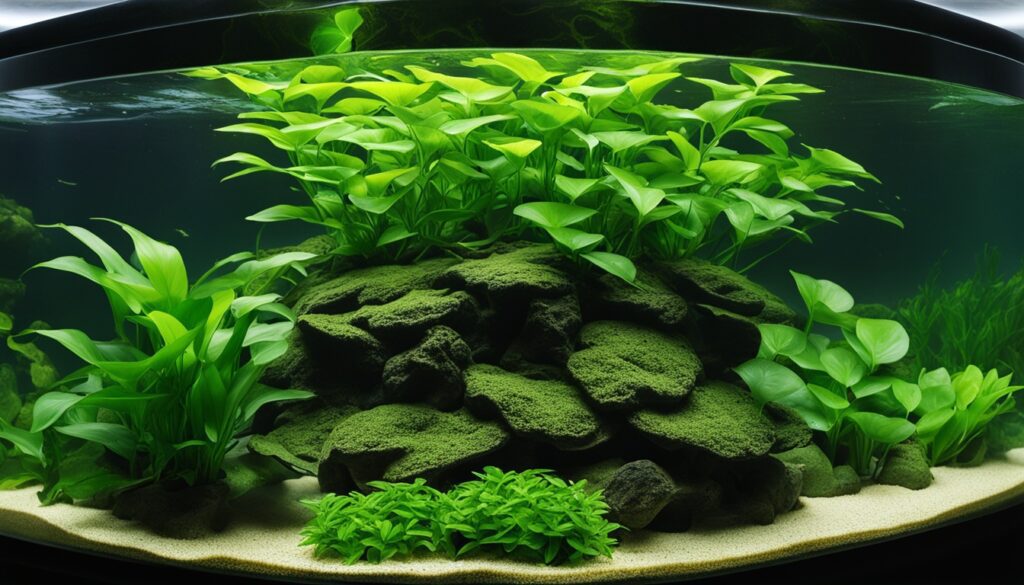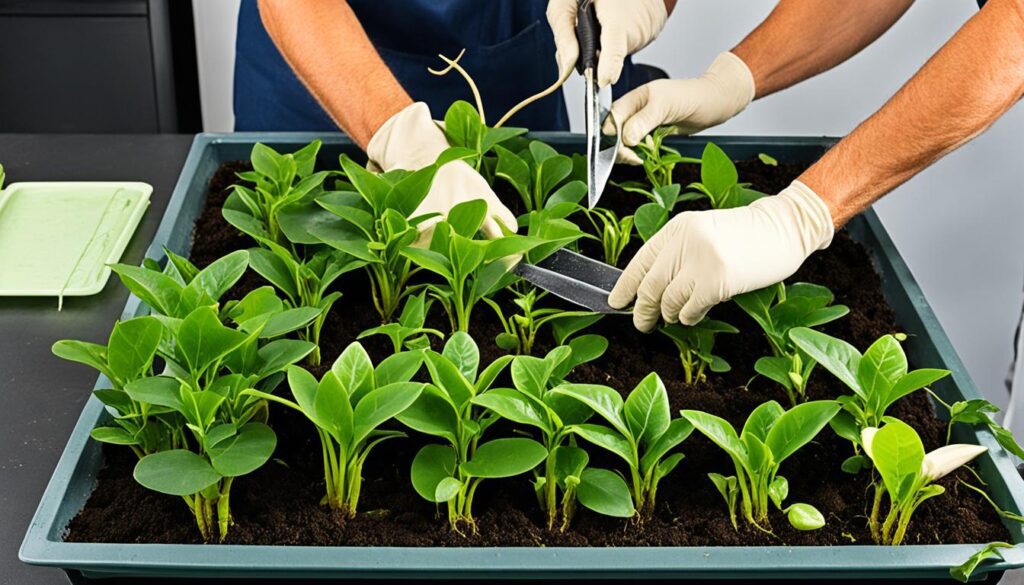Welcome to our guide on caring for Anubias Plant, where we’ll walk you through growing this lush aquatic plant in your aquarium. Anubias, originating from the tropical streams of Africa, is a favorite among aquarists for its durability and vibrant green leaves. With unique leaves that can be either round or long, these plants really make a statement in any tank.
Anubias is super easy to care for and can thrive in a variety of aquarium setups. Whether you choose to keep them as standalone plants or attach them to driftwood or lava rock, they’re perfect for both beginners and experienced aquarium enthusiasts.
Understanding the growth rate of Anubias is essential for proper care. The Dwarf Anubias, for instance, grows slowly, reaching about 15 centimeters tall. When planting, make sure the roots are around 1-2 centimeters long to give them a strong start. If you’re eager to see faster growth, adding CO₂ to your tank can give them a boost.
For successful propagation, ensure that each new Anubias plant has at least 3-4 healthy leaves. Keep an eye out for yellowing or melting leaves, which could indicate a need for more nutrients or better lighting.
Anubias can grow well under a range of light conditions, but be mindful of algae growth, which can be managed with the right lighting. Whether you’re caring for the smaller Anubias Nana or the larger Anubias Barteri, maintaining a pH between 6.5 and 7.8 and a temperature between 72 and 78 degrees Fahrenheit is key to keeping them healthy.
Now, let’s dive deeper into caring for Anubias roots and leaves, and how to seamlessly integrate these plants into your aquarium. Anubias can truly transform your tank with their vibrant appearance and resilience. Join us as we explore the world of Anubias care, and watch these plants thrive in your aquatic environment.
Anubias Plant Spotlight

Welcome to a deeper dive into the anubias plant, a key player in aquascaping. It’s known for its toughness and easy care. Getting to know this rhizome plant well will help you create a thriving underwater world. This is true whether you’re an expert or just starting out.
Anubias Genus and its Aquarium Popularity
The anubias plant comes from the shaded streams and rivers of western and central Africa. It’s famous for its strong nature and low maintenance. As a rhizome plant, it has a thick stem that stores nutrients, helping it survive in different water environments.
Its dark green leaves and adaptability make it perfect for both beginners and experts. It gets along well with many fish species and can live in low light. These traits make it a top choice for anubias aquariums.
Primary Varieties of Anubias: Attributes and Suitability
There are many anubias types, each fitting into different aquatic setups. Let’s look at some popular ones:
Variety |
Leaf Size |
Placement in Tank |
Special Features |
|---|---|---|---|
Anubias Nana |
0.5 – 5 inches |
Foreground to midground |
Compact growth, suitable for smaller tanks |
Anubias Barteri Var. Nana ‘Petite’ |
Up to 0.5 inch |
Foreground |
Extremely small leaves, ideal for nano tanks |
Anubias Barteri Var. Nana ‘Golden’ |
Up to 5 inches |
Mid to background |
Bright green leaves, adds vibrant color |
Anubias ‘Golden Coin’ |
Round, circular |
Midground |
Distinctive round leaves, aesthetic appeal |
Anubias Nana ‘Pinto’ |
Varies |
Foreground to midground |
White-green variegated leaves, unique patterns |
Anubias ‘Snow White’ |
Similar to other nana types |
Foreground to midground |
Requires higher lighting, striking white leaves |
Each anubias type adds its own look and function to the aquarium. Whether you want a calm, elegant look or a bold contrast with Anubias Nana ‘Pinto’, these plants fit many setups. They make the aquarium look better and feel more alive.
Essential Care for a Thriving Anubias Plant

The Anubias plant is a favorite in my aquariums for its tough beauty and resilience. It’s perfect for low-light spots in your tank. Knowing how to care for it is key to making your aquarium better.
Lighting Preferences
Anubias plants do well in low to moderate light. They’re great for shaded areas in your aquarium. For a lush look, use 2-3 watts per gallon of LED or fluorescent lighting. This helps prevent algae and highlights the plant’s deep green color.
Water Parameters and Temperature
Anubias plants like a slightly acidic to neutral pH (6.0 to 8.0) and temperatures between 72°F and 82°F. Keeping your aquarium water right helps these plants grow well. They add oxygen and help create a balanced ecosystem.
Root Anchoring Techniques on Decor
Anubias plants fit well in many aquarium setups. You can tie their rhizomes to driftwood or rocks. This not only looks good but also lets the plant get nutrients from the water easily.
There are easy ways to keep the anubias plant in place. You can use thread or safe glue to tie it down. As it grows, it will stick to the surface naturally.
Anubias Type |
Preferred Lighting |
Ideal Water Temperature |
Recommended pH |
|---|---|---|---|
Anubias Nana |
Low to Moderate |
72°F – 82°F |
6.0 – 7.5 |
Anubias Barteri |
Moderate |
72°F – 82°F |
6.5 – 8.0 |
Anubias Congensis |
Low |
72°F – 82°F |
6.0 – 7.0 |
Anubias Plant Growth Rate and Propagation

The Anubias is a plant from West Africa, loved for its slow-growing nature and easy care. It grows new leaves every 4-6 weeks, making it perfect for those who like a relaxed approach to gardening.
Anubias propagation is easy thanks to rhizome division. You can split one plant into several, each with its own rhizome and leaves. This method helps the plant grow and stay healthy by avoiding overcrowding.
Anubias can live in a variety of water conditions, liking a pH of 6.0 to 7.5 and temperatures between 22-28°C (72-82°F). It’s great for both beginners and experts in aquarium keeping. Plus, it doesn’t need much light or CO2, saving money for plant lovers.
For the best growth, use an iron-rich fertilizer to keep the Anubias green and healthy. Place it in the mid-ground or background to add height and beauty to your tank.
For more care tips and to see different Anubias species, visit Aquascaperoom. They offer top-quality aquatic plants and expert advice.
Characteristic |
Detail |
|---|---|
Family Name |
Araceae |
Origin |
West Africa |
Height |
15-40 cm (6-16 inches) |
pH Range |
6.0 – 7.5 |
CO2 Requirement |
Low to None |
Growth Rate |
Slow |
Care Level |
Easy |
Water Conditions |
22-28°C (72-82°F), soft to moderately hard |
Max Size |
Up to 40 cm (16 inches) |
Lighting |
Low to Moderate |
Supplements |
Iron-rich fertilizer |
Placement |
Mid-ground or Background |
Propagation |
Rhizome division |
By following simple steps, you can create a beautiful underwater world with Anubias. It brings a touch of West Africa’s beauty to your home aquarium.
Anubias Plant Roots & Leaves

Welcome to the world of Anubias plants, where strong roots, healthy leaves, and beautiful aquariums meet. I’ve grown these tropical plants in many tanks and learned how to make them look great and stay healthy. Let’s see how to take care of their roots and leaves.
Maintaining Robust Root Systems
Ensuring Anubias roots are strong is a big part of their care. These roots help the plant stay stable and get the nutrients it needs. They like to wrap around driftwood or sink into fine aquasoil. This way, they can get minerals without rotting from being buried too deep. Keeping them a bit above the soil helps them get the nutrients they need, keeping them healthy and effective at getting nutrients.
Preventing Algae Buildup and Encouraging Vibrant Leaves
For Anubias leaves to stay healthy and prevent algae, managing light and nutrients is key. Algae grow too much with too much light and the wrong nutrients. I use the right amount of light and add CO2, which stops algae from growing on leaves. Cutting off yellow or damaged leaves saves nutrients and keeps the plant looking good and full of life.
Key Element |
Details |
Impact |
|---|---|---|
Lighting & CO2 |
Moderate lighting paired with consistent CO2 supply |
Enhances leaf health and prevents algae |
Nutrient Management |
Regular dosing of nitrogen, phosphorus, potassium |
Improves overall vitality and color of leaves |
Leaf Maintenance |
Periodic pruning of damaged or old leaves |
Encourages new growth and reduces algae vulnerability |
By paying attention to Anubias roots, leaves, and preventing algae, you can make sure they not only survive but thrive in any aquarium. A well-cared-for plant shows its beauty through its healthy leaves and strong roots, adding to the beauty of the aquarium.
Placement and Compatibilities
When I explore aquascapes, I see how placing Anubias right is key. Anubias coffeefolia is known for its beauty and adaptability. It’s a key plant in creating beautiful aquatic environments.
First, Anubias coffeefolia should be placed thoughtfully to use its growth and fit well with other compatible aquarium plants. It does best in the front to middle of the tank, under low to moderate light. This plant grows slowly and doesn’t need much CO2, making it good for many tank setups.
Adding Anubias to aquascapes makes the tank look better and helps the ecosystem. Here’s a closer look at its features that make it versatile in aquatic environments.
Characteristic |
Detail |
|---|---|
Height |
15-30 cm (6-12 inches) |
pH Range |
6.0 – 7.5 |
Growth Rate |
Slow |
Max Leaf Size |
Up to 18 cm (7 inches) long |
Water Temperature |
22-28°C (72-82°F) |
Lighting Needs |
Low to Moderate |
Care Level |
Easy |
CO2 Requirement |
Low to None |
Color Form |
Green, with wavy leaves and bronzed hue when new |
Supplements |
Iron-rich fertilizer, generally undemanding |
Putting these elements together in my tank shows how Anubias and other plants work together. Anubias is elegant and helps create a peaceful underwater world.
Anubias fits well with many tank setups, making it great for both new and experienced aquarists. Its calm presence creates a lush green background. This highlights the vibrant colors of other fish and plants in the tank.
The Many Benefits of Anubias in Your Aquarium
Exploring the world of aquascaping, I’ve found many benefits of Anubias plants. They come in beautiful green colors and have tough leaves that handle different water conditions well. This plant is great for both new and experienced aquarists, needing little light and no CO2 but growing better with them.
Anubias plants grow slowly and are easy to care for, perfect for those with busy schedules. But they’re not just easy to look at; they help keep the water healthy. By making oxygen through photosynthesis, they support aquatic life and create a lively home for fish. They also help control algae by eating excess nutrients, preventing algae from taking over.
These plants make the water clean and keep algae away, providing a safe place for fish and invertebrates to hide and lay eggs. I’ve seen how Anubias makes my aquarium more lively and my fish healthier. Since they’re pest-free and safe for invertebrates, I trust Anubias to be a key part of a healthy aquarium. Still, I know it’s important to follow quarantine rules and report any problems to ensure the plant thrives in my tank.








